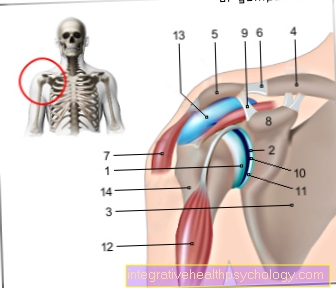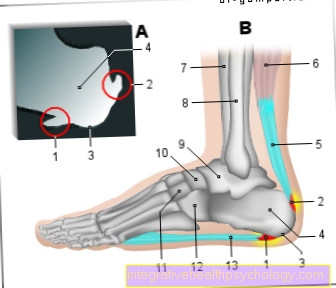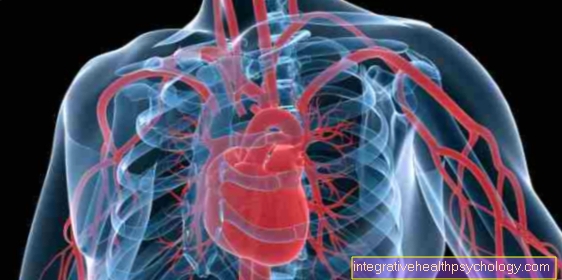Anesthetics
General
Anesthetic (General anesthetics) are substances that are usually used before a major operation to ensure that patients are neither conscious nor feel pain during the operation, the reflexes are switched off and the muscles are relaxed.

Nowadays there are usually several for one anesthetic Medication as a combination, so as few as possible Side effects of anesthesia arise and the best possible results can be achieved. The substance groups for anesthesia can therefore be divided into different groups:
Anesthetic gasesAlso, inhalation anesthetics, are gaseous or liquid substances that are administered via the airways and from there are distributed throughout the body.
Medicationthat are administered through the vascular system. This group of substances includes sleeping pills, pain relievers (Analgesics), as well as muscle relaxants that ensure complete relaxation of the muscles during the procedure.
As a rule, the anesthesia is in the form of a balanced anesthesia carried out. This means that different drugs of these substance classes are combined.
List / names of anesthetics
Inhalation anesthetics

Inhalation anesthetics are gases that maintain anesthesia.
Today gases only play a subordinate role in anesthesia.
- Sevoflurane,
- Desflurane
Injection anesthetics (sleeping pills)
- Propofol
- Thipental
- Etomidate
- Ketamine
Read more about this under Ketamine and Propofol.
Opiates and opidoids
Opiates and opioids (morphine) are used against during anesthesia in order to keep pain at a tolerable level during and after the anesthesia. In particular, the early administration of opiates and opioids has proven itself in terms of saving painkillers.
However, this group of active ingredients is mainly for Nausea after anesthesia responsible.
- Morphine
- Fentanyl
- Sufentanil
- Alfentanil
- Remifentanil
- Dipidolor
Read more about the topics:
- Nausea after anesthesia
- opiate
(Non-opioid) pain relievers
- Novaminsulfon (Novalgin®)
- Paracetamol
Non-depolarizing muscle relaxants
- Mivacurium
- Atracurium
- Rocuronium
The effect of non-depolarizing muscle relaxants can be canceled immediately by a so-called antidote.
Antidote:
- Neostigmine
- Pyridostigmine
Depolarizing muscle relaxants
- Succinylcholine
Emergency medication
Emergency medication is used for incidents such as cardiac arrest, drop in blood pressure, malignant hyperthermia or allergic reactions during anesthesia.
The following active ingredients are used:
- adrenaline
- Norepinephrine
- Amiodarone
- Atropine
- Prednisolone
- Dantrolene (malignant hyperthermia)
Anesthetic gas
Anesthetic gas is the term used to describe anesthetics that are administered through the airways and are distributed in the blood via the lungs. The substances can be divided into two different groups. On the one hand the substances that are gaseous at room temperature, laughing gas and xenon, and on the other hand the so-called volatile anestheticswhich are in liquid form, but can also be administered via the airways via a carburetor. The drugs of this group commonly used in Germany are isoflurane, sevoflurane and desflurane.
Laughing gas
Nitrous oxide, or laughing gas in common usage, is an inhaled anesthetic that also has a pain-relieving effect. The use of nitrous oxide is declining in medicine. It is often used in combination with other anesthetics. In dentistry, it continues to play an important role as a sedative, for example for anxious patients or children. When used properly, nitrous oxide has few side effects.
For more information, see: Laughing gas
Anesthetics given intravenously
In most cases, a combination of different groups of active ingredients is used for anesthesia. Under certain circumstances, however, intravenous medication alone may be used for anesthesia (total intravenous anesthesia = TIVA).
Reasons for this can be an intolerance to anesthetic gases or known overreactions to other drugs. In the substance group of intravenously administered anesthetics, a distinction is made between various active substances that have different influences on the body during the impairment of consciousness.
An intravenous line must be established prior to induction of anesthesia using these drugs. The substances are then fed into the vein using modern syringe pumps. The use of these syringe pumps enables the substances to be administered very precisely, which is of considerable advantage due to the not inconsiderable effects of an overdose.
So-called hypnotics (sleeping pills) are responsible for the loss of consciousness. The drugs used, mostly propofol (phenol derivative (diisopropylphenol, in oily suspension)) or thiopental (group of barbiturates).
. They ensure the sleep phase during anesthesia. However, they alone would not be sufficient for an anesthetic, as they have only a minor muscle-relaxing function and no pain-relieving effect.
For the analgesic effect, highly effective substances are given that fall into the group of opioids. The advantage, in addition to its analgesic effect, is the simultaneous dampening of the vegetative reflexes as well as causing a memory gap (amnesia) after the procedure. Since some anesthetics can cause serious nightmares, this memory gap is intentional and beneficial.
Finally, muscle relaxants should be mentioned as part of intravenous anesthetics. These drugs prevent impulses from being transmitted from the brain to the muscles, causing reversible paralysis. Muscle relaxants are not necessary for every operation, but they do make intubation easier.
Propofol
Propofol belongs to the group of intravenous narcotics and represents the Standard drug to induce anesthesia It is also good for a TIVA (total intravenous anesthesia). It is conducted into the blood through a vein and works there after 30-40 seconds for one Duration of action of 5-8 minutes. It is given continuously during surgery. Propofol causes a loss of consciousness in the body. It also works "amnestic“Which means after the procedure no memories of the period during the administration of the agent has. In addition, it causes a weakening of the breathing reflexes in the throat, which is beneficial for anesthesia, leads to a Drop in blood pressure and reduces the risk of postoperative vomiting and nausea. The injection of Propofol is often found painful, but waking up and feeling after anesthesia is often described as pleasant.
Also read: Short anesthesia with propofol
Which anesthetics are used for short anesthesia?
A colonoscopy is usually performed on the awake patient, as the procedure is uncomfortable but not very painful. Most often, patients are given a sedative, such as Dormicum (midazolam). This will cause them to sleep during the exam. It is also possible to have the colonoscopy under a short anesthetic. In this case, the drug propofol is used.
It puts the patient in a comfortable, short sleep. Propofol is given by vein shortly before the gastroscopy starts. Possible side effects are a drop in blood pressure and decreased respiratory drive. As a result, the drug must not be given to patients with unstable circulation and all patients must remain in the hospital or doctor's office for observation for a few hours after the colonoscopy.
Dormicum
Dormicum or Midazolam belongs to the group of benzodiazepines. Dormicum is preferred for sedation before surgical interventions or diagnostic measures. Patients are not anesthetized under Dormicum, but often fall asleep. Dormicum can also be used as a tablet for short periods of time against sleep disorders. Long-term use for more than two weeks leads to dependencies. Dormicum should not be used in children or adolescents or in patients with hepatic insufficiency.
Read more on the topic: Dormicum
ether
Ether is a historical anesthetic that was used for anesthesia for the first time in the 19th century. The discovery of ether was particularly essential for surgery, as until then patients could only be shielded from the pain of an operation with alcohol and opiates.
Today ether is no longer used as an anesthetic because ether-air mixtures have a high risk of explosion. In addition, there are now more controllable anesthetics, which work for a shorter time than ether and whose side effects are not so unpleasant.
Read more on the subject at: Ethereal anesthesia
Anesthetic for gastroscopy
For a gastroscopy, usually only the throat wall is numbed by a spray with a local anesthetic such as lidocaine. Some doctors also use sedatives routinely or at the patient's request. Anesthetics such as propofol or midazolam are used here. Sedation has the advantage that the patient does not tense up so much during the examination and can no longer remember the unpleasant examination as well after the examination.
For more information on sedation, read our article: Sedation - Everything You Should Know
Anesthetics for colonoscopy
A colonoscopy is usually performed on the awake patient, as the procedure is uncomfortable but not very painful. Most often, patients are given a sedative, such as Dormicum (midazolam). This will cause them to sleep during the exam. It is also possible to have the colonoscopy under a short anesthetic. In this case, the drug propofol is used. It puts the patient in a comfortable, short sleep. Propofol is given by vein shortly before the gastroscopy starts.
Possible side effects are a drop in blood pressure and decreased respiratory drive. As a result, the drug must not be given to patients with unstable circulation and all patients must remain in the hospital or doctor's office for observation for a few hours after the colonoscopy.
Also read the article on the topic: Anesthesia for a colonoscopy - is that dangerous?
Anesthetic at the dentist
For most dental procedures, one is enough local anesthesia in the oral cavity. Be for it Local anesthetics at the dentist such as lidocaine used. If there are major interventions, such as an operation on several wisdom teeth or teeth that have been relocated to the palate, sedation or anesthesia is also used. A nitrous oxide sedation can be used to calm down and relax (without loss of consciousness!). Laughing gas is inhaled through a mask. The procedure is particularly suitable for treating children. Regular anesthesia with ventilation (intubation anesthesia) can also be used. Here the However, ventilation tube inserted through the nose, as the operation is carried out in the oral cavity. The anesthetic propofol is administered as an induction, which leads to a complete loss of consciousness.
Induction of anesthesia
At the beginning of every anesthetic there is the so-called induction. Anxiety medication can be prescribed hours before the procedure, if necessary. Depending on the induction of anesthesia intravenous or inhalative respectively. For intravenous introduction, a peripheral or central venous catheter is required to deliver the medication into the vasculature. As soon as such access is available, hypnotics (sleeping pills), pain relievers, and muscle relaxants are administered.
Alternatively, induction of anesthesia can also be used inhalative done by means of an anesthetic gas. This method is particularly interesting for people for whom intravenous access is not easily possible while awake (for example children).
After each induction of anesthesia, the airways must be secured and the patient must be ventilated, as the muscle-relaxing medication no longer allows the patient to breathe on its own.
Please also read the article on the topic: Induction of anesthesia.
tenance of anesthesia
As a rule, maintenance of anesthesia is carried out according to a balanced model. This means that anesthetic gas and intravenously administered medication are used in combination. Under certain circumstances, a purely intravenous maintenance must take place, in which the medication is precisely dosed Syringe pumps administered.
One pure inhalative taining the anesthesia is possible by adding Laughing gas to a volatile Anesthetic gas, however, is no longer common these days.
Diversion

After each procedure under anesthesia, there is the so-called diversion. The medication is stopped and it is waited until the active ingredients have been exhaled or broken down by the body. In some cases, it may be useful to give antidotes to help you wake up faster. In most cases, however, pain relievers should continue to be given, as severe pain is usually the foreground after an operation under general anesthesia.
Effect of anesthetics
Sleeping pills
Sleep pills induce deep sleep through various mechanisms that all intervene in the central nervous system.
The sleeping pill is usually given at the beginning of the anesthesia, and sleep is then maintained by the anesthetic gases.
Alternatively, the sleeping pill can be administered continuously (TIVA).
Read more on the topic: Sleeping pills
Painkiller
Since more pain is to be expected during an operation, opiates are usually used.
They block the pain receptors in the central nervous system and thus the transmission of pain to the brain.
But also lighter pain relievers such as Novalminsulfon (Novalgin) or Paracetamol are usually administered intravenously.
Read more under our section: Painkillers
Muscle relaxants
Drugs from the Group of muscle relaxants prevent the transmission of excitation from the nerve cell to the muscle cell.
Since no signal arrives in the muscle, it relaxes.
Inhalation anesthetics / gas / anesthetic gas
Inhalation anesthetics are delivered through the windpipe as gases or vaporized liquids. They cause unconsciousness, muscle relaxation and pain inhibition.
Inhalation anesthetics (anesthetic gas) are used for maintenance, especially in children, also to induce anesthesia.
The exact mechanism is not certain; many different structures are believed to be affected.
What influence do anesthetics have on liver values?
Whether anesthetics have an influence on the liver values cannot be said in general, but has to be considered separately for the individual drugs. Propofol is broken down by the liver, but usually does not lead to an increase in liver values.
Propofol infusion syndrome is a complication of the administration of propofol. In addition to serious derailments in the acid-base balance, there is also a massive increase in liver values. Ketamine is also broken down in the liver. With the regular use of ketamine, solely for anesthesia, no changes in the liver values should occur. However, if ketamine is taken for several days, it is liver-toxic and leads to an increase in liver values.
Side effects of anesthetics
Like most medications, anesthetics have side effects. The most unfortunate side effect of anesthetics is the death of the patient. Nowadays this side effect is less common than it was a few decades ago. On average, the mortality rate for patients without relevant comorbidities is around 0.4 cases per 100,000 anesthesia.
A well-known side effect of anesthetics is the inhibition of the regulation of the vascular system. Usually the muscles of the vasculature are controlled by the autonomic nervous system regulated. This regulation does not apply when the anesthetic is administered, which explains a drop in blood pressure. At the same time there is a reduced beating power of the heart. This drop in blood pressure can be compensated for by giving fluids or blood concentrates, but it can also occur in patients with previous illnesses Cardiac arrhythmias, and even for Cardiac arrest to lead.
Another side effect, which is mostly related to Muscle relaxants is brought about is the occurrence of allergic reactions. In most cases these are only mildly pronounced, but can sometimes even be allergic shock lead, a life-threatening condition that must be monitored by intensive care.
A dreaded side effect of anesthetics, especially in the group of anesthetic gases, is the clinical picture of malignant hyperthermiawhich is associated with an increased body temperature. The symptoms of malignant hyperthermia are very variable and usually extremely life-threatening. By introducing a new drug (Dantrolene) however, the death rate has fallen sharply.
After the operation, the affected person may also feel the effects of the anesthetic. Many treated patients experience moderate to severe nausea and vomiting after the procedure. The reason for this is usually the anesthetic gases used. In order to prevent this postoperative nausea, inhalative anesthesia can be dispensed with and purely intravenous anesthesia can be performed.
An overdose of many anesthetics can also have undesirable effects that endanger the life of the patient. The effect and active ingredient concentration of the anesthetic agent must be determined by one during the entire procedure Anesthetists be observed to prevent overdosing or underdosing the medication. Overdosing would have drastic consequences and endanger the patient's life. In the worst case, underdosing could no longer ensure the patient's freedom from pain during the procedure. It is owed to the modern possibilities, which enable the monitoring of the patient in real time, that undesired side effects of the anesthetics used can be recognized and treated as quickly as possible.
Read more under our topics:
- Side effects of anesthesia
- Side effects of general anesthesia





























